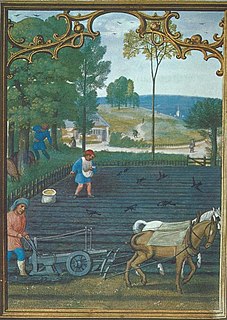 W
WAgriculture in the Middle Ages describes the farming practices, crops, technology, and agricultural society and economy of Europe from the fall of the Western Roman Empire in 476 to approximately 1500. The Middle Ages are sometimes called the Medieval Age or Period. The Middle Ages are also divided into the Early, High, and Late Middle Ages. The early modern period followed the Middle Ages.
 W
WAgriculture in the Middle Ages describes the farming practices, crops, technology, and agricultural society and economy of Europe from the fall of the Western Roman Empire in 476 to approximately 1500. The Middle Ages are sometimes called the Medieval Age or Period. The Middle Ages are also divided into the Early, High, and Late Middle Ages. The early modern period followed the Middle Ages.
 W
WThe Byzantine economy was among the most robust economies in the Mediterranean for many centuries. Constantinople was a prime hub in a trading network that at various times extended across nearly all of Eurasia and North Africa. Some scholars argue that, up until the arrival of the Arabs in the 7th century, the Eastern Roman Empire had the most powerful economy in the world. The Arab conquests, however, would represent a substantial reversal of fortunes contributing to a period of decline and stagnation. Constantine V's reforms marked the beginning of a revival that continued until 1204. From the 10th century until the end of the 12th, the Byzantine Empire projected an image of luxury, and the travelers were impressed by the wealth accumulated in the capital. All this changed with the arrival of the Fourth Crusade, which was an economic catastrophe. The Palaiologoi tried to revive the economy, but the late Byzantine state would not gain full control of either the foreign or domestic economic forces.
 W
WThe economics of English agriculture in the Middle Ages is the economic history of English agriculture from the Norman invasion in 1066, to the death of Henry VII in 1509. England's economy was fundamentally agricultural throughout the period, though even before the invasion the market economy was important to producers. Norman institutions, including serfdom, were superimposed on an existing system of open fields.
 W
WHops are the flowers of the hop plant Humulus lupulus, a member of the Cannabaceae family of flowering plants. They are used primarily as a bittering, flavouring, and stability agent in beer, to which, in addition to bitterness, they impart floral, fruity, or citrus flavours and aromas. Hops are also used for various purposes in other beverages and herbal medicine. The hops plants have separate female and male plants, and only female plants are used for commercial production. The hop plant is a vigorous, climbing, herbaceous perennial, usually trained to grow up strings in a field called a hopfield, hop garden, or hop yard when grown commercially. Many different varieties of hops are grown by farmers around the world, with different types used for particular styles of beer. The first documented use of hops in beer is from the 9th century, though Hildegard of Bingen, 300 years later, is often cited as the earliest documented source. Before this period, brewers used a "gruit", composed of a wide variety of bitter herbs and flowers, including dandelion, burdock root, marigold, horehound, ground ivy, and heather. Early documents include mention of a hop garden in the will of Charlemagne's father, Pepin III.
 W
WThe medieval English wool trade was one of the most important factors in the medieval English economy. 'No form of manufacturing had a greater impact upon the economy and society of medieval Britain than did those industries producing cloths from various kinds of wool'. The trade's liveliest period, 1250–1350, was 'an era when trade in wool had been the backbone and driving force in the English medieval economy'.
 W
WAgriculture in Scotland in the Middle Ages includes all forms of farm production in the modern boundaries of Scotland, between the departure of the Romans from Britain in the fifth century and the establishment of the Renaissance in the early sixteenth century. Scotland has between a fifth and a sixth of the amount of the arable or good pastoral land of England and Wales, mostly located in the south and east. Heavy rainfall encouraged the spread of acidic blanket peat bog, which with wind and salt spray, made most of the western islands treeless. The existence of hills, mountains, quicksands and marshes made internal communication and agriculture difficult. Most farms had to produce a self-sufficient diet of meat, dairy products and cereals, supplemented by hunter-gathering. The early Middle Ages were a period of climate deterioration resulting in more land becoming unproductive. Farming was based around a single homestead or a small cluster of three or four homes, each probably containing a nuclear family and cattle were the most important domesticated animal.
 W
WThe three-field system is a regime of crop rotation that was used in China since ancient times and in medieval and early-modern Europe. Crop rotation is the practice of growing a series of different types of crops in the same area in sequential seasons.